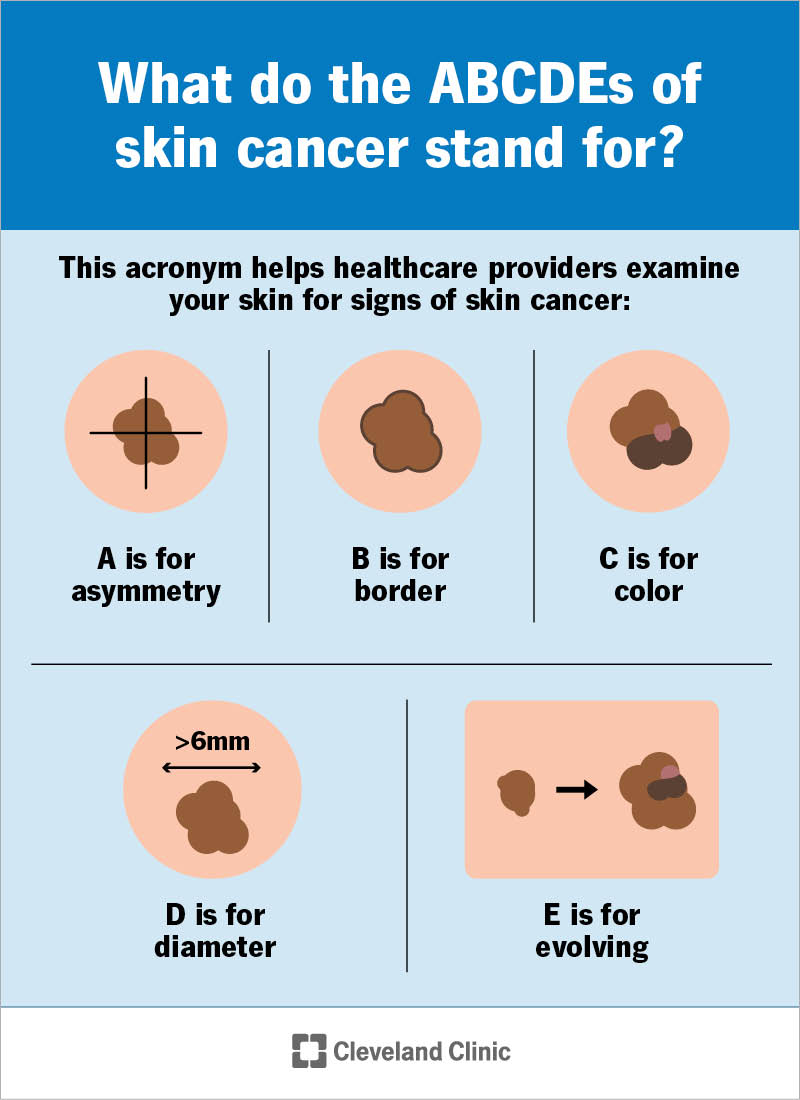The ABCDEs of melanoma are an easy way to remember what to look for in a suspicious mole. It stands for asymmetry, border, color, diameter and evolving. These signs can help you catch skin cancer early by performing a monthly self-exam. If something looks or feels off, talk to a provider.
Advertisement
Cleveland Clinic is a non-profit academic medical center. Advertising on our site helps support our mission. We do not endorse non-Cleveland Clinic products or services. Policy

The ABCDEs of skin cancer are five warning signs of melanoma. Melanoma is the most serious type of skin cancer. Each letter stands for a feature that describes a cancerous freckle or a mole:
Advertisement
Cleveland Clinic is a non-profit academic medical center. Advertising on our site helps support our mission. We do not endorse non-Cleveland Clinic products or services. Policy
If you notice any of the ABCDEs of skin cancer, call your provider right away. An early diagnosis and treatment improve outcomes.
Melanoma is serious, but it’s highly treatable when caught early. That’s why it’s important to check your skin regularly. You know your skin best, so you’re most likely to spot changes, like a new mole or a freckle that looks bigger or crustier than before. Catching these signs early gives you the best chance for a cure.
If you have lots of freckles or moles, you might notice one that looks different from the rest. Maybe it’s scabbed over, has grown or is more raised than before. That one spot stands out. That’s what providers call the “ugly duckling” sign. Just like in the childhood story, it refers to a mole or freckle that doesn’t match the others. It could be a warning sign of melanoma.
You can perform this skin check at home. Use a well-lit room, a full-length mirror and a hand mirror. Follow these steps:
Advertisement
During your self-exam, note any moles, blemishes or birthmarks from head to toe. Use a small ruler to measure their size, and watch for changes in color, shape or size, or any sore that doesn’t heal. Taking photos can help you track changes over time.
Check your skin about once a month, ideally after a bath or shower. Keep track of any spots or changes and where they appear. Contact your provider if you notice anything new or changing.
Checking your skin may feel unfamiliar at first, but it’s a simple habit that comes with real power. There’s no harm in doing it, and it could help you spot something important.
Skin changes often appear slowly. Getting to know your skin well means you’ll be able to easily spot when something’s out of place. That awareness may lead to faster answers. Catching skin cancer in its early stages gives you more options — and a much better shot at successful treatment.
But don’t panic — not every skin change is cancer. And not every lesion that meets the ABCDE or ugly duckling criteria is skin cancer. You should still trust your instincts. And if something doesn’t look or feel right, reach out to your provider. A quick check-in could make all the difference.
Reach out to your provider if you notice:
Your dermatologist can evaluate and treat suspicious areas early. They’ll also track any changes over time. If you’re at a higher risk for melanoma or other skin cancers, your provider may recommend regular checkups.
It may be scary to find a mole or area of your skin that seems different or unusual. But the good news is that with early detection, most skin cancers are treatable if caught in time. Understanding what to look for in identifying skin cancer is key to diagnosing and treating it.
Advertisement
Every day, people see your skin, hair and nails. At Cleveland Clinic, our expert and caring dermatology team will make sure they’re healthy and strong.

Last reviewed on 08/21/2025.
Learn more about the Health Library and our editorial process.